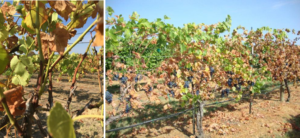By Fran Pontasch (July 29, 2018)
The demand of carrying a grape crop to harvest is stressful for grapevines, even when rainfall and high temperatures are normal. This season is placing extraordinary demands on our grapevines. Demands for water vary by soil type, vine age, competition from weeds, and temperature.
Water loss from evaporation and transpiration must be replenished so the vines can continue to function. In drought conditions, the older, basal leaves dry out and brown, leaving a diminished number of functioning leaves, and fruit quality can be affected if the berries do not receive their essential requirements. In addition, berry pH tends to elevate and berries ripen faster in extremely hot, dry weather. Drought stress causes variation within the vineyard, thus a larger berry or cluster sample is needed to represent an upcoming harvest. Conversely, excess water intake will slow the accumulation of sugar. Combined with an extended period of cloud cover, the ripening process tends to stall.
Some of the Visual Signs and Effects of Drought Stress
- Leaf margins become scorched
- Basal leaves become chlorotic and drop. Tendrils wilt and brown.
- Fruit ripening delay or stalls. Berries shrivel
- Periderm formation starts early and can be incomplete

The root system is dynamic. When water is limited, roots die back. The root tips regenerate as water availability increases. Irrigate carefully to replenish lost water without overwatering.
Irrigation need can be determined by how much water is used and lost in the vineyard due to evaporation and transpiration (evapotranspiration). The Texas ET website reports evapotranspiration estimates by area at http://texaset.tamu.edu/

Below are the calculations for irrigation need using current data from http://texaset.tamu.edu/, adapted from an example provided by Dr. Justin Scheiner, Texas A&M Agrilife Extension Viticulture Specialist .
Location: 12′ x 6′ vineyard – College Station/Bryan
Vines: Mature, at harvest
Date: July 20, 2018 through July 26, 2018
1 acre inch = 27,154 gallons
1) Determine the reference ET (ETo) for a given irrigation period and adjust using proper crop coefficient. Determine the proportion (%) of ET you want to replace
ETo = 2.07 inches
Crop coefficient = 0.7
ET replacement = 80%
2.07 inches ETo x 0.7 crop coefficient x 0.80 ET replacement = 1.159 inches
1.159 inches x 27,154 gallons per acre inch = 31,471.486 gallons
2) Determine irrigation system output
Vines per acre = 43,560 square feet per acre / 12’ row x 6’ vine spacing = 605
Emitters per vine = 2
Emitter output = 1 gallon per hour (gph)
Drip irrigation efficiency = 90% (approx. 10-15% is lost to evaporation)
605 vines x 2 emitters per vine x 1 gallon per hour / 0.90 irrigation system efficiency = 1,344 gallons per hour total outpu
3) Determine irrigation system run time to replenish the water lost during the last 7 days in BCS
31,471.486 gallons to apply / 1,344 gallons per hour output = 23.41 hours of run time
Particular sites’ water demands vary by soil depth, soil type, canopy, vine age, etc, so keep in mind that the calculation is an estimate. Vines need a lot of water now, and most systems are not capable of delivering the determined amount of water for the determined run time … do the best you can, grapevines are pretty tough.